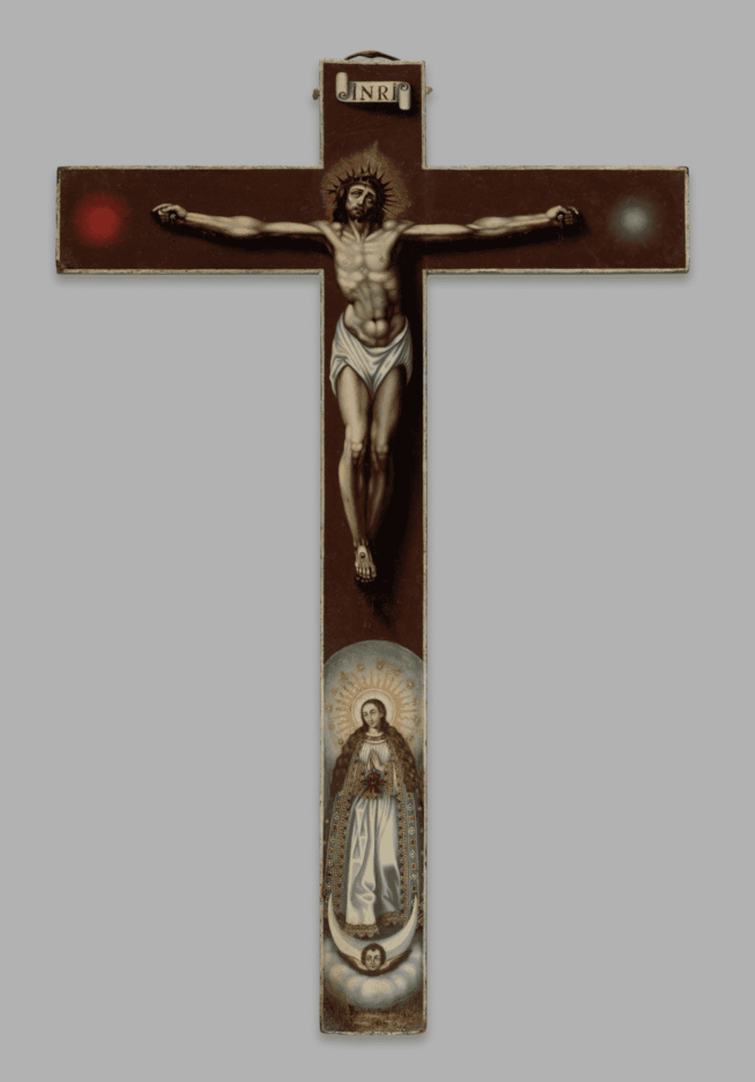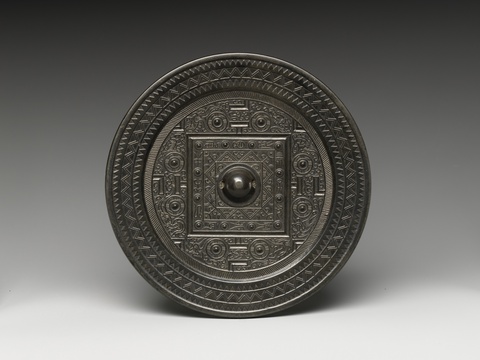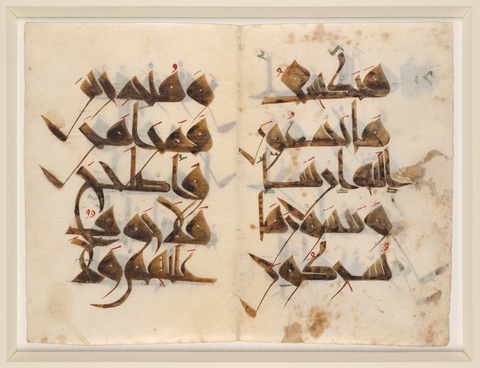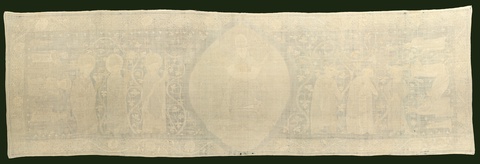Women Artists and the Divine
By Reina Gattuso•March 2024•9 Minute Read

Maria Josefa Sanchez, Crucifixion, 1646. Oil on panel, 63 x 39 cm. Art Institute of Chicago, CC-0.
Religious stories in many societies ascribe potent creative powers, both reproductive and artistic, to goddesses and everyday women. Across cultures, women creatives, from nuns to calligraphers, have also made works revering the divine.
Introduction
Religious and magical traditions have often ascribed special creative powers to women, feminine people, and people who give birth. Across cultures, female deities are often patrons of a particular art or craft, particularly textile production and ceramics. Stories about goddesses as artists often connect this divine creativity to the power of people with wombs to craft human life.1
Meanwhile, many women have found freedom making art within religious institutions. Often, a monastic or ascetic life was, and in some contexts remains, one of the only avenues for women to thrive outside of the institution of marriage. Religious expression could provide a socially sanctioned means of accessing literacy and artistic training. Women religious artists sometimes gained fame—and perhaps divine favor—through their works.
“Fertility” Figurines
Some of the earliest known representations of the human body, including the so-called Venus of Hohle Fels and Venus of Willendorf, represent fleshy bodies with vulvas and breasts. Archaeologists, largely male, conventionally interpreted them as representing fertility goddesses, and implied that they were made by men looking at women.
Paleolithic figure Venus of Hohlefels, 2011. Wikimedia commons, CC BY-SA 3.0.
Some feminist art historians have supported the interpretation of these figurines as goddesses, claiming they point to ancient matriarchies. Others have challenged this interpretation as applying an anachronistic view of gender to diverse times and places.2 Feminist art historians have suggested various other interpretations. For example, some have argued that women most likely created the figurines as a form of self-representation, modeling them after their views of their own pregnant bodies.3
Goddess as Artist: Nüwa and Panthoibi
Many cultures associate women with clay, often in creation myths involving flooding. In one story, for example, after a great flood, the Chinese creator goddess Nüwa and her brother sculpted the first human beings from yellow clay.4

Meanwhile, in the cosmology of Meitei people from Manipur, in what is now Northeast India, the domestic protector god Sanamahi was born from a clay jug made by the creator deities Atiya Shidaba and Leimarel Sidabi. Meitei cosmology continues to associate clay jugs with wombs and with the craft goddess Panthoibi, an incarnation of Leimarel Sidabi. Some contemporary local potters recognize this divine lineage by sprinkling colored water over their clay to thank the deities.5 Longpi ware, traditionally made by men of the Tangkhul Naga community and associated with Panthoibi, is the most famous kind of pottery from Manipur today.
Longpi pottery of Thankul Naga tribes, 2021. Sumita Roy Dutta, Wikimedia commons, CC BY-SA 4.0.
Textile arts, too, often have a divine origin associated with female deities and women’s creativity. Archaeological and folkloric traditions connect women and weaving in contexts as dispersed as ancient Indo-European myth, ancient China, and Finland. In numerous folkloric traditions, weaving is associated with women’s domestic spaces, and thus with the matriline.6 Similarly, nuns working in Catholic cloisters frequently produced textiles glorifying God and the church, as in the altarcloth pictured in this feature.
Catholic Devotional Artists: María Josefa Sánchez and the Altenberg Nuns
In Medieval and early modern Europe, Catholic religious veneration offered women an outlet for emotional and intellectual expression within largely patriarchal cultures.7 Many of these artists resided in convents, where they practiced needlework and painting as a form of devotion and to supply the needs of the parish. Most of their identities are unknown except through their works and tantalizing clues such as signatures.
In the late 1300s, three nuns named Sophia, Hadewigis, and Lucardis embroidered an elaborate linen altarcloth in the convent of Altenberg, in what is now Germany. Using white satin thread on white linen, the nuns embroidered images of the three magi as well as Christ, Saint Nicholas, and Saint Elizabeth of Hungary and Thuringia, the mother of a local Altenberg abbess. The mix of biblical and local figures suggests that the nuns understood themselves and their convent as playing a role in the history of Catholicism. Alongside their names, the nuns inscribed a prayer that Jesus find their work acceptable.
Some women, like painter María Josefa Sánchez, became well-known for painting religious themes. Sánchez was active in the Iberian Peninsula, likely Castile, in the 1640s. Art historians speculate she may have been a nun. They recognize five existing works by Sánchez; all are small-scale crucifixes, a typical genre of the time intended for personal Catholic devotion, including within convents.
A 1646 example currently housed at the Art Institute of Chicago consists of a cruciform panel on which Sánchez painted Jesus Christ on a cross in oils. It is one of only three works by an early modern woman artist in the museum’s collection.8
Sacred Calligraphy: Al-Shifa’ bint Abdullah, Durrah al-Katiba, Zaynab bint Ahmad al-Maqdisiyya, and Esmâ Ibret Hanim
From the earliest days of Islam, Muslims have celebrated the sacred written word as embodied in the Qur’an. This contributed to the development of a rich calligraphic tradition. Across medieval Islamicate Africa, Asia, and Europe, artists used calligraphy to adorn everything from architecture to textiles.9 Here, we’ll focus on calligraphy in ink on parchment and paper.
Dating to the founding of Islam, women played significant roles in transmitting knowledge, including through calligraphy.10 Historians remember Al-Shifa’ bint Abdullah, a companion of the Prophet, as a calligrapher who taught women writing. Historic and contemporary scholars have documented many other Muslim women calligraphers by name, while the names of many others were not recorded.11

Around 1020 CE in the Fatimid Caliphate of what is now Tunisia, a learned woman named Fatima al-Hadinah, governess of the Zirid prince, commissioned the creation of a Qur’an to be donated to the Great Mosque of Kairouan. Inscriptions on the Qur’an tell us that a woman named Durah al-Katiba (“Durah the Scribe”) oversaw its production. Creating this Qur’an would have required a workshop full of calligraphers. Durah al-Katiba also likely wrote portions of the calligraphy. Women in the Zirid court frequently commissioned and donated precious Qur’ans such as this, demonstrating their power and piety.12
In 1330 CE, a renowned Damascus- or Jerusalem-based scholar named Zaynab bint Ahmad al-Maqdisiyya, also known as Zaynab bint al-Kamal, completed an ornate copy of the Qur’an which now resides in Cairo’s Museum of Islamic Art. Zaynab was a renowned woman scholar of the Mamluk Sultanate. She received many ijazahs, written licenses that teachers give students, entitling them to transmit specific types of knowledge. Zaynab bint al-Kamal’s biography appears in multiple chronicles documenting the lives of esteemed scholars.13
Hilye-i sharif, written by the sülüs-nesih line, by Esmâ İbret Hanım. Museum of Turkish and Islamic Arts. Public domain.
Meanwhile, Esmâ Ibret Hanim was the most renowned woman calligrapher of the 18th century Ottoman Empire. Sultan Selim III was so impressed by her calligraphy that he granted her a daily allowance. She created the delicately ornamented hilye pictured here. Hilye is an Ottoman calligraphic form that extolled the virtues of the Prophet and his companions.14
Learn More about Women Artists
Women’s authorship of creative works can be hard to establish, especially for objects in the distant past. Yet religious institutions often afforded women space (if frequently limited) to acquire and demonstrate profound creative skill, and record their names in written history.
This feature is the second installment in Curationist’s seven-part series on women artists in our partner archives. For a guide to the series as a whole, see the introduction, “Women Artists and the Museum.” For more about women artists working in state-sponsored and courtly production systems, see part three of the series.
Reina Gattuso is a content writer on the Curationist team, and an independent journalist covering gender and sexuality, arts and culture, and food. Her journalism connects analysis of structural inequality to everyday stories of community, creativity, and care. Her work has appeared at Atlas Obscura, The Washington Post, Teen Vogue, The Lily, POPSUGAR, and more. Reina has an MA in Arts and Aesthetics (cinema, performance, and visual studies) from Jawaharlal Nehru University in New Delhi, India, where her research focused on sexuality in Hindi film. She writes and teaches writing to high school students in New York City.
Suggested Readings
“Arabic Calligraphy.” Museum With No Frontiers.
Barker, Sheila. “Foreword: Women Artists in the Cloister.” In Artiste nel Chiostro. Memorie Domenicane, 2015.
McCoid, Catherine Hodge and Leroy D. McDermott. “Toward Decolonizing Gender: Female Vision in the Upper Paleolithic.” American Anthropologist, vol. 98, no. 2, 1996, pp. 319–326.
Rizvi, Uzma Z. and Vali, Murtaza. “The Fertile Goddess at the Brooklyn Museum of Art: Excavating the Western Feminist Art Movement and Recontextualizing New Heritages.” Near Eastern Archaeology 72:3, 2009.
Citations
For textiles in the ancient Mediterranean, see: Ackerman, Susa. “Asherah, the West Semitic Goddess of Spinning and Weaving?” Journal of Near Eastern Studies vol. 67, no. 1, 2008, https://www.journals.uchicago.edu/doi/pdf/10.1086/586668?casa_token=rzKDUT6iAV8AAAAA:iFwT9w04wpmC67iEw9tAgACJ2aRDcZ3ScxmLDTJ08S3Cdcbhn-YCUmkdsE8rLFFrIVpkkHU7ghk. Accessed 27 January 2024. For textiles in early Japan, see: Miller, Alan L. "Ame No Miso-Ori Me" (The Heavenly Weaving Maiden): The Cosmic Weaver in Early Shinto Myth and Ritual.” History of Religions, vol. 24, no. 1, August 1984, https://www.jstor.org/stable/1062345. Accessed 27 January 2024. For ceramics, see: Vincentelli, Moira. Women and Ceramics. Manchester University Press, 2000.
Rizvi, Uzma Z. and Murtaza Vali. “The Fertile Goddess at the Brooklyn Museum of Art: Excavating the Western Feminist Art Movement and Recontextualizing New Heritages.” Near Eastern Archaeology 72:3, 2009, https://www.academia.edu/1823605/The_Fertile_Goddess_at_the_Brooklyn_Museum_of_Art_Excavating_the_Western_Feminist_Art_Movement_and_Recontextualizing_New_Heritages. Accessed 26 February 2024.
McCoid, Catherine Hodge and Leroy D. McDermott. “Toward Decolonizing Gender: Female Vision in the Upper Paleolithic.” American Anthropologist, vol. 98, no. 2, 1996, pp. 319–326, https://www.jstor.org/stable/682890. Accessed 7 March, 2024.
“Nüwa.” Wikipedia, https://en.wikipedia.org/wiki/N%C3%BCwa. Accessed 24 April 2023.
Balasubramaniam, Chitra. “Longpi – Black Pottery from Manipur.” Ceramics Technical, no. 27 Nov 2008, pp. 20, https://search.informit.org/doi/abs/10.3316/informit.921986292566343. Accessed 25 April 2023.
Feminists working in the psychoanalytic tradition have developed this idea to great depth. See: Bergren, Ann. “Female Fetish Urban Form.” In Weaving Truth: Essays on Language and the Female in Greek Thought. Hellenic Studies Series 19, 2008, https://chs.harvard.edu/chapter/weaving-in-architecture-the-truth-of-building-10-female-fetish-urban-form/.
Barker, Sheila. “Foreword: Women Artists in the Cloister.” In Artiste nel Chiostro, Memorie Domenicane, 2015, https://www.academia.edu/30721163/Foreword_Women_Artists_in_the_Cloister. Accessed 30 January 2024.
“María Josefa Sánchez’s Crucifixion.” The Art Institute of Chicago, 31 October 2019, https://www.artic.edu/articles/780/maria-josefa-sanchezs-crucifixion. Accessed 27 April 2023.
“Arabic Calligraphy.” Museum With No Frontiers, https://islamicart.museumwnf.org/exhibitions/ISL/arabic_calligraphy/introduction.php. Accessed 26 April 2023.
Sayeed, Asma. “Muslim Women’s Religious Education in Early and Classical Islam.” Religion Compass, vol. 5, no. 3, March 2011, https://doi.org/10.1111/j.1749-8171.2011.00263.x. Accessed 26 April 2023.
Blair, Sheila S. Islamic Calligraphy. Edinburgh University Press, 2020.
Information about the Qur’an’s calligraphy and the context of women patrons comes from three sources: Ekthiar, Maryam. “Bifolio from the Mushaf al-hadina (Nurse's Qur'an).” The Metropolitan Museum of Art, https://www.metmuseum.org/art/collection/search/456074. Accessed 30 January 2024; “Arabic Calligraphy.” Museum With No Frontiers, https://islamicart.museumwnf.org/exhibitions/ISL/arabic_calligraphy/?lng=en. Accessed 30 January 2024; “Page from a Qur’an.” Museum With No Frontiers. https://islamicart.museumwnf.org/database_item.php?id=object;ISL;tn;Mus01;4;en&pageT=N. Accessed 30 January 2024.
Sayeed, Asma. Women and the Transmission of Knowledge in Islam. Cambridge University Press, 2013, https://doi.org/10.1017/CBO9781139381871.005. Accessed 26 April 2023.
“Esmâ Ibret Hanim.” Wikipedia, https://en.wikipedia.org/wiki/Esm%C3%A2_Ibret_Hanim. Accessed 26 April 2023.
Reina Gattuso is a content writer on the Curationist team, and an independent journalist covering gender and sexuality, arts and culture, and food. Her journalism connects analysis of structural inequality to everyday stories of community, creativity, and care. Her work has appeared at Atlas Obscura, The Washington Post, Teen Vogue, The Lily, POPSUGAR, and more. Reina has an MA in Arts and Aesthetics (cinema, performance, and visual studies) from Jawaharlal Nehru University in New Delhi, India, where her research focused on sexuality in Hindi film. She writes and teaches writing to high school students in New York City.

